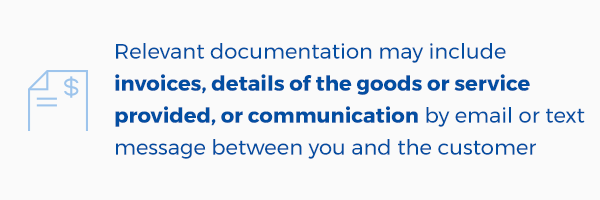How to Fight and Win Chargeback Disputes

Merchants in nearly every industry who accept credit cards encounter chargebacks from customers, including building and design professionals. Chargebacks were designed to ensure consumer protection against fraudulent billing, but can sometimes cause headaches for businesses who aren’t familiar with the process.
We’ll discuss how chargebacks work, the role of a merchant in the chargeback process and why having ClientPay on your side gives you a special advantage when you find yourself battling one.
What is a chargeback?
A chargeback occurs when a credit card or debit card user directly disputes a charge on their account with their issuing bank. The use of chargebacks in the U.S. dates back to 1968, when the Truth in Lending Act came into effect as a form of customer protection from unfair billing practices.
Types of chargebacks and common reasons they’re initiated
Chargebacks can be categorized broadly as fraudulent (either true fraud or friendly fraud) and non-fraudulent. The latter may occur due to a customer determining a product or service was defective or insufficient, or a miscommunication or lack of communication regarding a purchase between multiple people on a shared bank account.
It’s important for merchants to keep in mind that not all illegitimate chargeback requests are intended to unfairly dispute a transaction. Immediately blaming a customer for an unfair dispute could negatively affect your reputation and customer service record. In some cases, a customer’s payment data may be compromised and a purchase was made using their account without their permission (true fraud). However, if a chargeback originates without basis for any legitimate refund, you may find yourself fighting friendly fraud.
Friendly fraud describes when a customer tries to take advantage of a business by requesting a refund from their bank, despite the good or service they received being satisfactory and promptly delivered. This often occurs with a customer contacting their bank without reaching out to the business, since the bank likely hasn’t established a line of communication with the merchant beyond the exchanging of funds. In other words, the discrepancy pins the customer’s word against that of the business.

What’s essential for you to know about chargebacks
Are there fees for chargebacks?
When a business is unable to successfully combat a chargeback, the business will be forced to return the money from the transaction in question back to the customer. Additionally, merchants facing chargebacks are also responsible for paying fees issued by the customer’s bank, sometimes regardless of the outcome of the customer’s attempt. Associated fees are typically $20 or more, depending on the particular bank and the number of chargebacks a business has faced previously.
In addition, if payment processors deem a business as high risk due to a large number of chargebacks, higher processing fees may also be added to each of its transactions. According to NerdWallet, a competitive processing fee for a small business might be 0.3 percent on top of the interchange rate, while a processing fee for a high-risk business might be 1.5 percent on top of the interchange rate.

How many chargebacks can merchants have?
There is no uniform chargeback rate among a merchant’s total transactions that constitutes a business being labeled as high risk. For instance, Mastercard and Visa use the same formula to calculate a chargeback-to-transaction ratio (number of monthly chargebacks divided by number of monthly transactions), but the two networks reference different months in which the transactions occurred, according to Chargebacks911. Additionally, Mastercard and Visa only recognize chargebacks made using their card network, and there are many other networks with their own calculations, so it’s difficult to determine a threshold for all situations.
As a result, the general number your business should aim to stay below is 1 percent of your monthly transactions, which equates to 100 chargebacks per 10,000 transactions. However, networks will often issue warnings if your business begins to approach their specific high-risk rate.
Reason codes
To understand why a chargeback attempt was initiated, a merchant will need to check the corresponding reason code associated with the chargeback. Card networks list reason codes when a chargeback is requested, providing detail into the customer’s dispute. However, much like the variation in chargeback calculation rates among networks, each network has different reason codes.
As a merchant, it’s important to understand these codes so you can provide appropriate evidence in response to the customer’s claim. If you don’t know why a customer is seeking a chargeback, regardless of legitimacy, being unable to provide supporting documentation will hurt your chances of winning the dispute and retaining your earned funds.

Questions to ask yourself before handling a chargeback dispute?
Could this be resolved with customer service?
As mentioned previously, chargebacks are initiated for a variety of reasons. If you receive a chargeback notification, it may be necessary to contact the customer directly, especially if you determine beforehand that their claim is legitimate and without malicious intent. However, do not initiate a refund unless you’re certain the chargeback will be canceled by the customer.
It’s possible that a customer may take notice of your concern for their issue with your goods or service, in which case—congratulations, you’ve successfully avoided the potential hurdle of fighting the chargeback. Although, more often than not, a customer will initiate a chargeback if they feel the issue can’t be fixed easily or they don’t feel confident they’ll receive a refund from your business directly.
Am I at fault?
Ultimately, it's your job to determine if there was an error on your business’ part in successfully and accurately providing the goods or service to the customer. If you conclude that you’re in the wrong, by all means, attempt to issue a refund to the customer. An obvious and unintentional mistake shouldn’t have to undergo a messy conflict and the almost-certain permanent loss of a customer, not to mention the damage to your business’ reputation that may come with it.
How to win a chargeback without hurting your reputation?
Fighting the chargeback process with ClientPay
When you use ClientPay, your business is backed by risk and fraud analysts dedicated to helping navigate the chargeback process, so you always have a team at your defense. Our solution consistently limits liability for your business by offering free access to these experts, who can:
- Notify users of chargebacks and providing transaction details to identify the issue
- Request supporting documents from your business to verify the validity of the chargeback and reviewing them to determine your chances of successfully reversing the dispute
- Upload the accompanying documents to Merchant Services, the dispute committee for major U.S. card networks
- Provide status updates as your case progresses and answering any questions users may have about maintaining PCI compliance as well as associated rules and regulations

Best of all, ClientPay maintains an 80–85 percent chargeback win rate for building and design professionals who respond to chargeback notices.
How to proactively protect your business from a chargeback?
Authorization form
ClientPay provides free sample credit card authorization forms for building and design professionals to authorize credit card payments submitted by a client and to authorize payments from a third party paying on behalf of a client.
These forms make it simple for your business to schedule payments ahead of time or regularly charge a client at the same time each month. Having a client sign and submit these during your intake process will demonstrate their prior authorization of card use, helping your case in a possible chargeback dispute.
Proper documentation and record keeping
In general, keeping accurate records and detailed documentation of your transactions is a solid foundation for running a healthy business practice, but these measures will be essential to beat a chargeback.
Your responsibility is to act immediately by submitting appropriate evidence which proves the request of your customer was met effectively. Relevant documentation may include invoices, details of the goods or service provided, or communication by email or text message between you and the customer. ClientPay’s online payment solution allows convenient access to transaction data and custom reports to ensure your payment history is always securely on hand.

Despite the potential of chargebacks, accepting credit cards is ultimately important to your business
Unwarranted chargebacks are, of course, frustrating and somewhat unavoidable. That doesn’t mean the alternative of not accepting card payments is a greater option, it just means your business deserves an all-encompassing payment solution tailored to fit the needs of your operation.
While other online payment solutions lack the AEC industry knowledge and experience relevant to your business, ClientPay is a partner in your overall success. With proactive and reactive resources to beat chargebacks and the ability to accept client payments quickly and easily, the benefits of choosing ClientPay are unparalleled.
To start utilizing an online payment solution equipped with advanced chargeback protection, schedule a demo of ClientPay today!